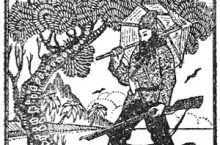Ski enthusiasts glide down the High Noon trail at Arapahoe Basin ski area on Wednesday. (Photo by Andy Cross/The Denver Post) Let’s be honest: The top skiers globally began their journeys as soon as they could walk. Within your ski circle, chances are the individual with the most polished technique takes on any terrain and […]


Ski enthusiasts glide down the High Noon trail at Arapahoe Basin ski area on Wednesday. (Photo by Andy Cross/The Denver Post)
Let’s be honest: The top skiers globally began their journeys as soon as they could walk.
Within your ski circle, chances are the individual with the most polished technique takes on any terrain and is always the first one to return to the lift, having learned early, fortunate to grow up in an area that supported skiing and with parents who encouraged it.
I was raised in the Midwest and didn’t hit the slopes until I was 30, after relocating to Colorado. Now, 20 years on, I ski 100 days each winter, and although I’m no expert, I’m happy skiing nearly everything I encounter.
The average age of skiers has climbed to 35, up from 30 a decade earlier and 24 back in the 1960s. Not everyone got the chance to learn as kids. A growing number of adults are embracing the sport, particularly as baby boomers reach retirement, enjoying more free time and extra spending money.
Many are discovering what I learned two decades ago—that it’s never too late to take up skiing or snowboarding.
Consider taking a lesson
Kyle Murphy frequently observes this at Breckenridge Resort, where he serves as the ski school director.
“You approach someone on a difficult run, and they’re trudging down the slope. ‘What’s happening?’ Murphy asks. “‘My friend brought me up the lift. It’s my initial skiing experience. They said I should just figure it out.’”
In an instance I witnessed, an adult was sliding down a black diamond trail on his backside. “Forget skiing,” he shouted back at the jeering onlookers from the lift.
Such are the risks of attempting without instruction.
“We observe a lot of hesitation among adult guests; they hear ‘ski school’ and think, ‘I don’t want to go to school. That’s for children,” he explains. “Many adults feel, ‘I can manage myself and work it out independently.’”
“Those are the individuals we aim to convince that, ‘Hey, we offer lessons for you. We can assist you in learning. We can get you started and ensure both fun and safety,’” he adds. “It’s a technical pursuit, and as with any sport, mastering the basics is vital.”
At Breckenridge, the predominant learners on any day are children, yet a significant number are adults participating in adult-only classes or private tutorials.
He emphasizes the importance of experienced instructors who are familiar with the mountain, able to guide you from the beginner slopes to easier runs safely, rather than, say, having your partner show you.
And naturally, a lesson is more affordable than a divorce. “For the sake of your relationship, consider a lesson.”

Ongoing education
For a large portion of my life, much like the 97 percent of Americans who don’t ski, I held onto the usual misconceptions: It’s costly, perilous, too distant, and I’m too advanced in age to pick up such a challenging activity.
Then I relocated to Colorado Springs, where my colleagues persuaded me to join them for an outing to Monarch Mountain, a quaint resort near Salida that offered free lift tickets in exchange for a canned food donation.
Following their suggestion, I signed up for a lesson. I was the eldest in the group. We practiced sliding on one ski. We learned how to position ourselves. We grasped the concepts of “pizza wedge” and “french fries.” After two hours, the instructor encouraged me to enjoy myself.
And I truly did.
I relished the excitement of sliding (awkwardly) down snow like sledding while being able to control my direction. I also appreciated the breathtaking views high in the Rockies during midwinter, unlike any I had experienced before.
How had I missed out on this until now? I lamented my upbringing in a flat region.
I skied until the lifts closed. From then until spring, I rented skis every weekend, discovering new areas. That summer, I bought my first pair of skis and my first season pass.
The learning curve was steep. Eager to challenge myself, I ventured into terrain beyond my skill level and slowly made my way down. In group outings, I often found myself lagging behind. I fell. And fell. And fell.
I reached a point where I felt stagnant in my progress, prompting me to take an intermediate-level lesson.
It turned out I had been using my poles incorrectly, attempting to slow down instead of utilizing them to assist with turning. Everything shifted. Soon, I found myself skiing 30-35 days each winter.
Then I took an advanced lesson and discovered I wasn’t skiing moguls correctly, as I wasn’t maintaining my shoulders facing downhill.
With time and practice, along with the move to the mountains and my wife allowing me to leave my job and become a ski enthusiast, I shed my fear and embraced the challenge of double diamonds.
And now, throughout the summer, I eagerly await winter.

Advice for newcomers
Murphy’s initial suggestion is to enroll in a lesson, a notion I wholeheartedly support.
“Our instructors will be equipped to guide you, whether you’re a newcomer, intermediate, or expert, in safely acquiring new skills. Our instructors won’t merely say, ‘Let’s tackle a black diamond run and teach you to ski bumps,’” he states.
“We’ll begin on an easier, green run, and progressively work up, ensuring that you are challenged while remaining safe.”
Second point: Advance at your own speed, rather than that of your partner or friends.
“You understand yourself better than anyone else, including your capabilities and limits, so it’s critical to develop and push yourself at a pace that is right for you.”
Third point: Keep in mind, everyone was a beginner once.
“Everyone starts in the same place, hauling their skis, struggling to walk to the base area in their ski boots… so it’s important, and this applies to picking up anything in later life, to not feel daunted or uncomfortable. Everyone who began, whether young or older, had to learn the basics like pizza wedge and french fries.”
Fourth point: Practice leads to perfection.
“If you pick it up at 30 and continue for the next decade, skiing 100 days each year, you might become a stronger skier than someone who started at 5 but only went four times a year. Picking up the sport later in life, when combined with lessons and consistent practice, allows you to reach a substantial level of skill.”
Fifth point: Ensure you have a good time.
“When you’re not perfecting that skill you desire, it’s easy to become frustrated; instead, concentrate on the enjoyment. You’re on the mountain, skiing, not stuck at a desk or in front of a computer, so relish it.”














